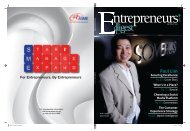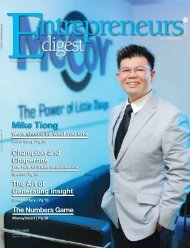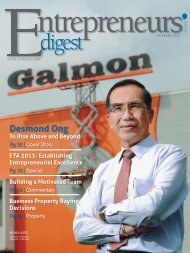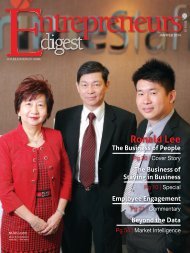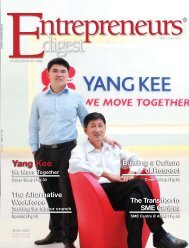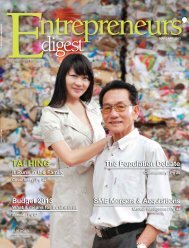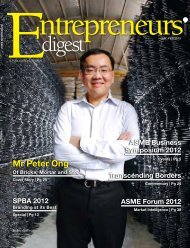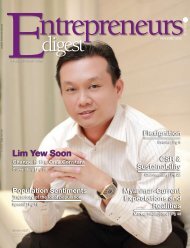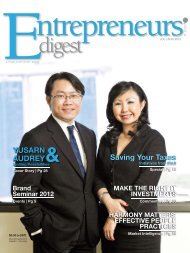ED 45
Create successful ePaper yourself
Turn your PDF publications into a flip-book with our unique Google optimized e-Paper software.
24<br />
cO m m E n ta r y<br />
on local and Foreign Talent<br />
In addition, there have been several<br />
controversies regarding intense job<br />
competition amongst locals and<br />
foreigners. Foreigners today make up<br />
21 per cent of our PMET workforce and<br />
this group of them comprise of mid to<br />
higher-skilled workers, complementing<br />
Singaporean workers by bringing skills<br />
that help companies sustain and grow.<br />
Tighter restrictions have been placed<br />
since the rise of many concerns regarding<br />
this issue to ease the job competition.<br />
However, implementing overly restrictive<br />
foreign manpower policies could make<br />
it difficult for businesses to operate<br />
Beyond these, there are also many other<br />
government initiatives that have been<br />
rolled out to encourage more women<br />
and older workers to enter and stay<br />
in the workforce. To name a few, the<br />
Capability Development grant (CDG)<br />
was launched two years ago in 2010, an<br />
initiative by the Workforce Development<br />
Agency (WDA) and is administered by<br />
ASME, was specially designed for SMEs<br />
to help them put in place human resource<br />
(HR) systems to facilitate practices in<br />
preparation for the Re-employment<br />
Legislation. An S$10,000 grant will be<br />
given to participating companies in this<br />
assistance scheme, which will help<br />
defray some of the costs to implement<br />
this HR system.<br />
On a more recent note, in a bid to<br />
promote work-life balance for women and<br />
mothers per se, the labour movement,<br />
sE p | Oc t 2012<br />
En t r E p r E n E u r s’ Di g E s t<br />
here, which could impact the livelihoods<br />
and jobs of Singaporeans if companies<br />
choose to relocate to other countries, a<br />
point that the Paper also raised.<br />
Several SMEs have already raised such<br />
a concern over the past few months,<br />
some even indicating that they are<br />
considering the option of relocating<br />
their operations overseas, to countries<br />
where their overall operational cost is<br />
lower, while others have considered the<br />
possibility of shrinking their operations in<br />
order to sustain their businesses.<br />
Examining the seriousness of this<br />
“A shrinking and ageing citizen workforce affects our ability to seize growth<br />
opportunities. A multi-pronged approach is thus required to sustain the<br />
economic vibrancy necessary to generate good employment opportunities<br />
for Singaporeans. Strategies include helping businesses to restructure and<br />
workers to upskill to improve productivity, encouraging more economically<br />
inactive citizens to enter the workforce, and supplementing the resident<br />
workforce with foreign manpower.”<br />
Issues Paper July 2012, National Population and Talent Division, Prime Minister’s Office<br />
National Trade Union Congress (NTUC),<br />
recommended working mums to be<br />
given six months of paid maternity<br />
leave, with another optional six months<br />
of unpaid leave. In addition, the Ministry<br />
of Community Development, Youth and<br />
Sports (MCYS) announced that recent<br />
amendments to the reimbursement of<br />
claims for Government Paid Maternity<br />
Leave (GPML), making it more flexible for<br />
companies and self-employed women to<br />
make more timely claims.<br />
To narrow the gap between SMEs and<br />
PMEs, the Max Talent scheme that was<br />
launched in April this year is a doubleedged<br />
initiative, aimed on the one hand<br />
– to enhance SMEs HR capabilities, to<br />
retain and attract local talents and PMEs,<br />
a challenge that many SMEs have raised,<br />
while on the other hand – for PMEs to<br />
secure gainful employment. SMEs can<br />
population trend, which has far-reaching<br />
effects to the social and economic future of<br />
Singapore, it is thus important to develop<br />
and implement policies and programmes<br />
to address the consequences.<br />
An Integrated Approach<br />
As part of the government’s initiative to<br />
better implement more multi-pronged<br />
policies, a dedicated website was<br />
launched to discuss all things population<br />
related. This includes areas ranging from<br />
supporting marriage and parenthood and<br />
managing immigration, to encouraging<br />
integration and promoting productivity.<br />
offer many interesting and challenging<br />
career opportunities for PMEs, a fact that<br />
is often not known to some job seekers.<br />
The Max Talent scheme is another WDA<br />
initiative, administered by ASME.<br />
In Conclusion<br />
As we continue to face the challenges<br />
and effects of a shrinking and ageing<br />
population, it is highly important for SMEs<br />
to embrace these structural changes,<br />
adapt and seek information and help<br />
on what is best for their companies<br />
out there in the market. It is also good<br />
for SMEs to participate more actively in<br />
feedback channels and forums, to give<br />
their feedback and insights on challenges<br />
they have encountered to the various<br />
government agencies, and provide<br />
rational advice on how to better raise<br />
productivity and improve labour force<br />
participation in Singapore.<br />
For more information on Max Talent, please contact the Max Talent secretariat at sme.maxtalent@asme.org.sg<br />
For more information on the Capability Development Grant, please contact prepare@edc-asme.sg<br />
Composition of Foreign Manpower<br />
(Excluding Foreign Domestic Workers) by Sectors<br />
Construction<br />
30%<br />
(292,500)<br />
Services<br />
43%<br />
(427,000)<br />
Others<br />
0.4%<br />
(41,000)<br />
Manufacturing<br />
27%<br />
(268,000)<br />
Composition of Singapore’s Total Workforce<br />
As at December 2011, our total workforce was 3.02 million, excluding foreign domestic<br />
workers. Residents (i.e. SCs ard PRs) formed the majority of the workforce at 67%, with<br />
foreign workers making up the remaining 33%.<br />
More than half of the resident workforce were professionals, managers, executives and<br />
technicians [PMETs].<br />
PMET<br />
Workforce<br />
Non-PMET<br />
Workforce<br />
Share of Foreign Workers in various sectors of<br />
Economy [Excluding Foreign Domestic Workers]<br />
( Dec 2011)<br />
Source: Ministry of Manpower<br />
Residents<br />
79%<br />
Residents<br />
57%<br />
Residents<br />
67%<br />
S Pass<br />
Holders<br />
4%<br />
EP<br />
Holders<br />
6%<br />
Work Permit Holders<br />
(Excluding Foreign<br />
Domestic Workers)<br />
23%<br />
Total Workforce (Dec 2011) : 3.02 million<br />
Source: Ministry of Manpower<br />
Non-Residents<br />
43%<br />
Non-Residents<br />
21%<br />
0% 20% 40% 60% 80% 100%<br />
Source: NPTD’s estimates using data from Ministry of Manpower; Non-residents and<br />
PMETs comprise EP and S pass holders.




